Examining Outsourcing Business Operations for Nike in Bangladesh
VerifiedAdded on 2021/06/17
|18
|3310
|186
Report
AI Summary
This report presents an in-depth analysis of Nike's outsourcing operations in Bangladesh. It begins with an introduction to outsourcing, its benefits, and the context of Bangladesh as an emerging market. The report outlines the project's objectives, scope, and research questions, followed by a comprehensive literature review covering the economic background of Bangladesh, the government's trade policies, and the impact of outsourcing on businesses like Nike. The research methodology section details the use of both qualitative and quantitative research approaches, including case studies, interviews, and questionnaires. The study aims to identify the challenges and opportunities of outsourcing business functions for Nike in Bangladesh, considering factors like cost reduction, supply chain efficiency, technological infrastructure, and cultural diversity. The report concludes by summarizing the key findings, discussing the implications of outsourcing for Nike, and recommending strategies for effective business operations in the context of Bangladesh.
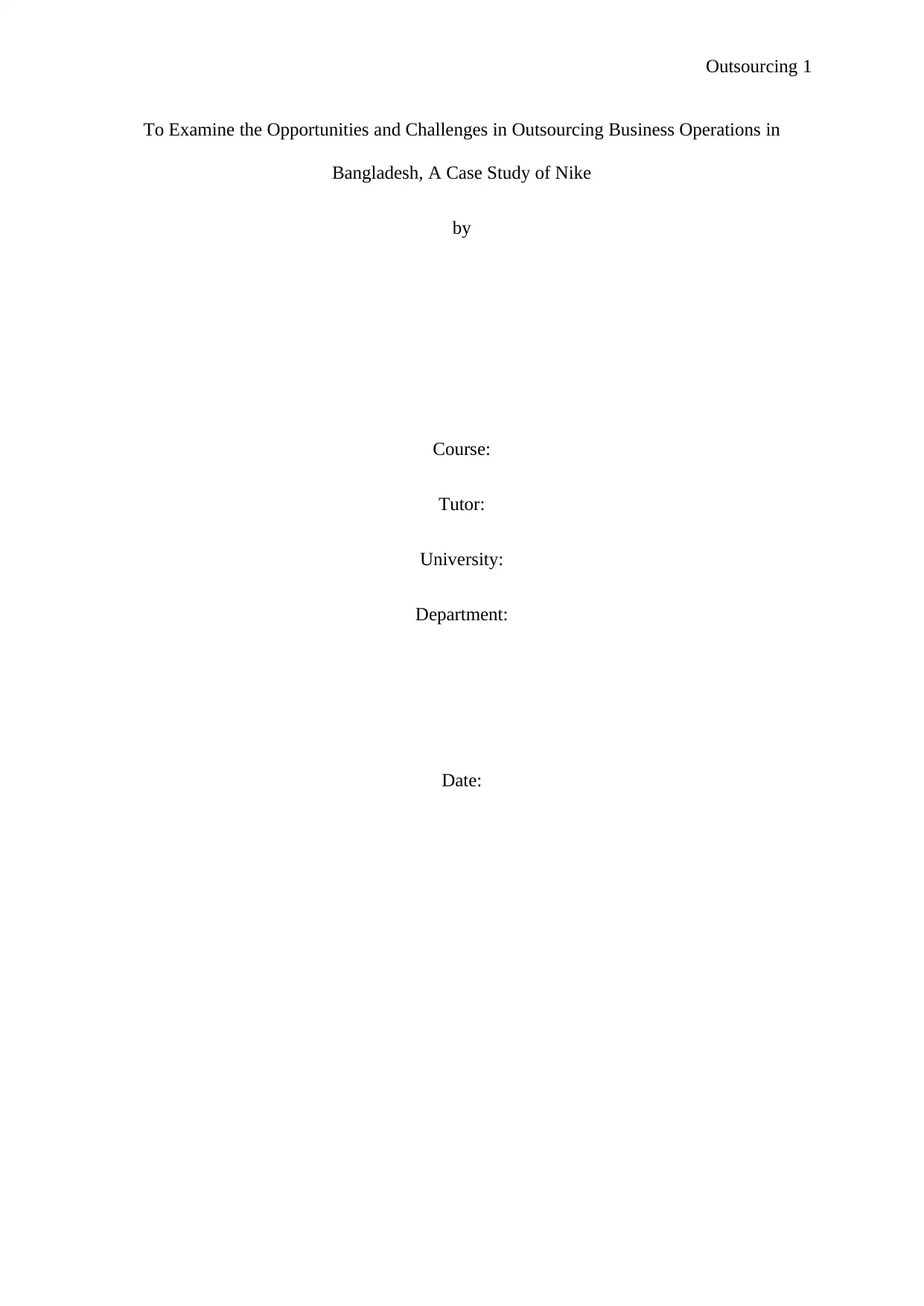
Outsourcing 1
To Examine the Opportunities and Challenges in Outsourcing Business Operations in
Bangladesh, A Case Study of Nike
by
Course:
Tutor:
University:
Department:
Date:
To Examine the Opportunities and Challenges in Outsourcing Business Operations in
Bangladesh, A Case Study of Nike
by
Course:
Tutor:
University:
Department:
Date:
Paraphrase This Document
Need a fresh take? Get an instant paraphrase of this document with our AI Paraphraser
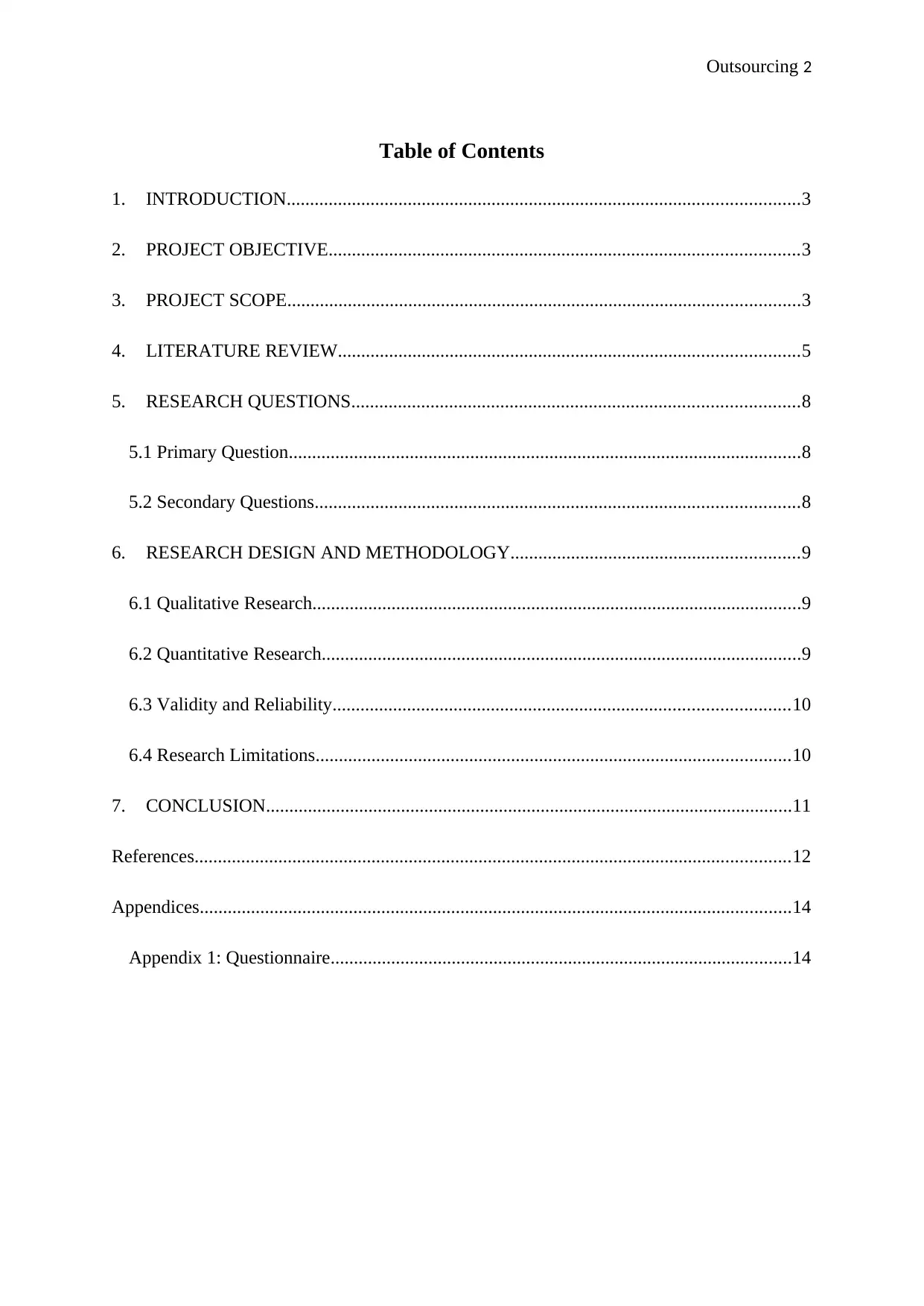
Outsourcing 2
Table of Contents
1. INTRODUCTION..............................................................................................................3
2. PROJECT OBJECTIVE.....................................................................................................3
3. PROJECT SCOPE..............................................................................................................3
4. LITERATURE REVIEW...................................................................................................5
5. RESEARCH QUESTIONS................................................................................................8
5.1 Primary Question..............................................................................................................8
5.2 Secondary Questions........................................................................................................8
6. RESEARCH DESIGN AND METHODOLOGY..............................................................9
6.1 Qualitative Research.........................................................................................................9
6.2 Quantitative Research.......................................................................................................9
6.3 Validity and Reliability..................................................................................................10
6.4 Research Limitations......................................................................................................10
7. CONCLUSION.................................................................................................................11
References................................................................................................................................12
Appendices...............................................................................................................................14
Appendix 1: Questionnaire...................................................................................................14
Table of Contents
1. INTRODUCTION..............................................................................................................3
2. PROJECT OBJECTIVE.....................................................................................................3
3. PROJECT SCOPE..............................................................................................................3
4. LITERATURE REVIEW...................................................................................................5
5. RESEARCH QUESTIONS................................................................................................8
5.1 Primary Question..............................................................................................................8
5.2 Secondary Questions........................................................................................................8
6. RESEARCH DESIGN AND METHODOLOGY..............................................................9
6.1 Qualitative Research.........................................................................................................9
6.2 Quantitative Research.......................................................................................................9
6.3 Validity and Reliability..................................................................................................10
6.4 Research Limitations......................................................................................................10
7. CONCLUSION.................................................................................................................11
References................................................................................................................................12
Appendices...............................................................................................................................14
Appendix 1: Questionnaire...................................................................................................14
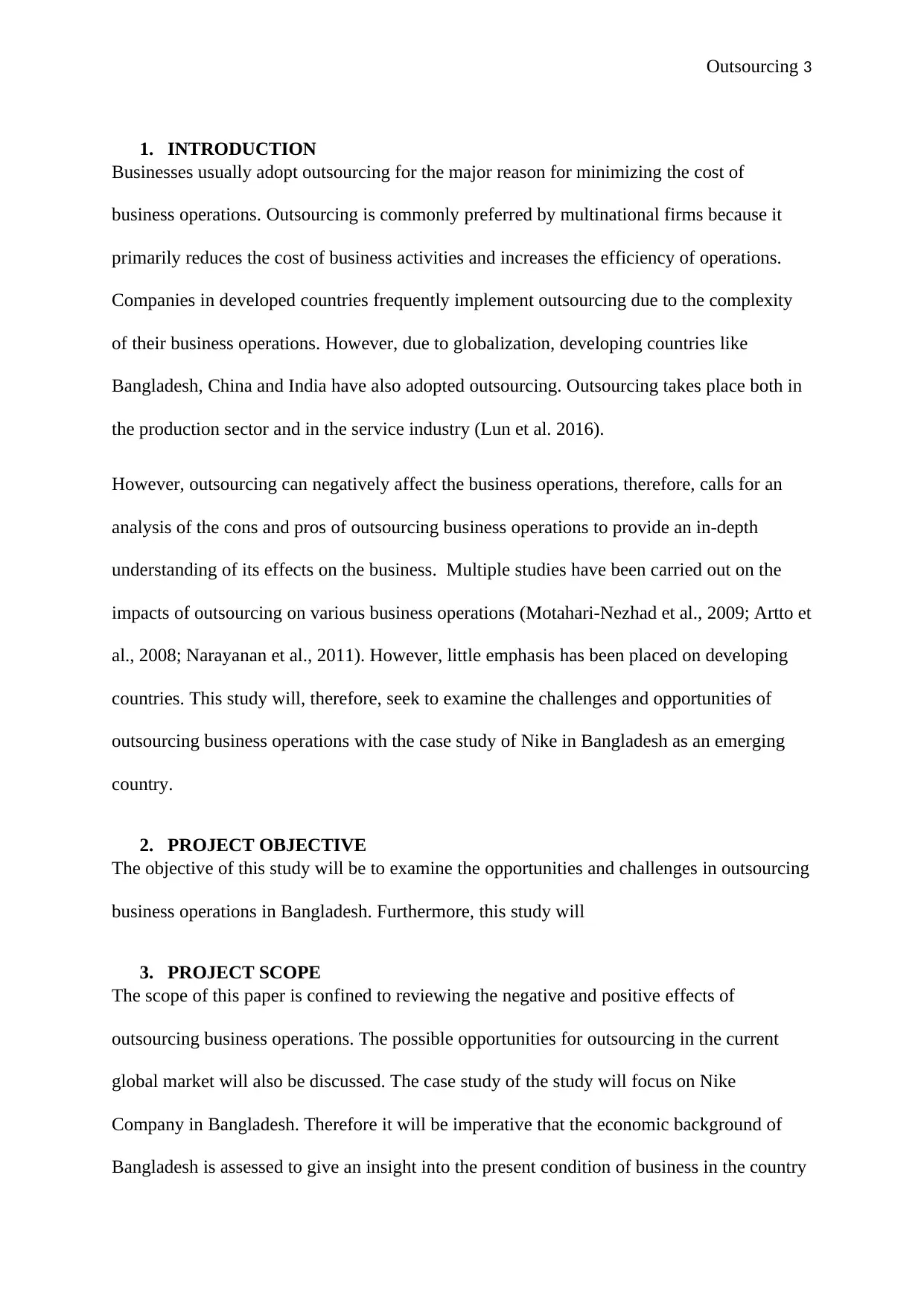
Outsourcing 3
1. INTRODUCTION
Businesses usually adopt outsourcing for the major reason for minimizing the cost of
business operations. Outsourcing is commonly preferred by multinational firms because it
primarily reduces the cost of business activities and increases the efficiency of operations.
Companies in developed countries frequently implement outsourcing due to the complexity
of their business operations. However, due to globalization, developing countries like
Bangladesh, China and India have also adopted outsourcing. Outsourcing takes place both in
the production sector and in the service industry (Lun et al. 2016).
However, outsourcing can negatively affect the business operations, therefore, calls for an
analysis of the cons and pros of outsourcing business operations to provide an in-depth
understanding of its effects on the business. Multiple studies have been carried out on the
impacts of outsourcing on various business operations (Motahari-Nezhad et al., 2009; Artto et
al., 2008; Narayanan et al., 2011). However, little emphasis has been placed on developing
countries. This study will, therefore, seek to examine the challenges and opportunities of
outsourcing business operations with the case study of Nike in Bangladesh as an emerging
country.
2. PROJECT OBJECTIVE
The objective of this study will be to examine the opportunities and challenges in outsourcing
business operations in Bangladesh. Furthermore, this study will
3. PROJECT SCOPE
The scope of this paper is confined to reviewing the negative and positive effects of
outsourcing business operations. The possible opportunities for outsourcing in the current
global market will also be discussed. The case study of the study will focus on Nike
Company in Bangladesh. Therefore it will be imperative that the economic background of
Bangladesh is assessed to give an insight into the present condition of business in the country
1. INTRODUCTION
Businesses usually adopt outsourcing for the major reason for minimizing the cost of
business operations. Outsourcing is commonly preferred by multinational firms because it
primarily reduces the cost of business activities and increases the efficiency of operations.
Companies in developed countries frequently implement outsourcing due to the complexity
of their business operations. However, due to globalization, developing countries like
Bangladesh, China and India have also adopted outsourcing. Outsourcing takes place both in
the production sector and in the service industry (Lun et al. 2016).
However, outsourcing can negatively affect the business operations, therefore, calls for an
analysis of the cons and pros of outsourcing business operations to provide an in-depth
understanding of its effects on the business. Multiple studies have been carried out on the
impacts of outsourcing on various business operations (Motahari-Nezhad et al., 2009; Artto et
al., 2008; Narayanan et al., 2011). However, little emphasis has been placed on developing
countries. This study will, therefore, seek to examine the challenges and opportunities of
outsourcing business operations with the case study of Nike in Bangladesh as an emerging
country.
2. PROJECT OBJECTIVE
The objective of this study will be to examine the opportunities and challenges in outsourcing
business operations in Bangladesh. Furthermore, this study will
3. PROJECT SCOPE
The scope of this paper is confined to reviewing the negative and positive effects of
outsourcing business operations. The possible opportunities for outsourcing in the current
global market will also be discussed. The case study of the study will focus on Nike
Company in Bangladesh. Therefore it will be imperative that the economic background of
Bangladesh is assessed to give an insight into the present condition of business in the country
⊘ This is a preview!⊘
Do you want full access?
Subscribe today to unlock all pages.

Trusted by 1+ million students worldwide
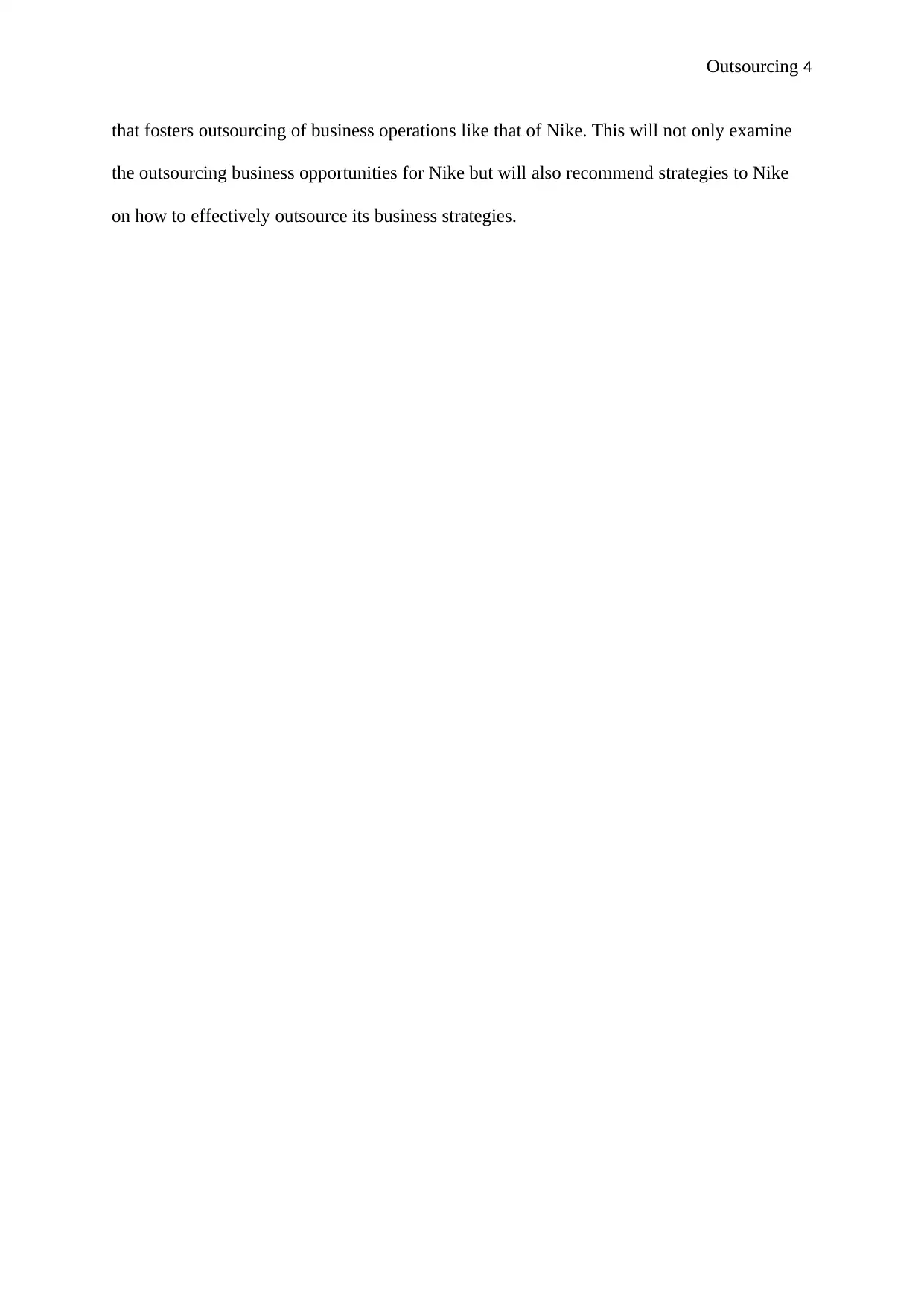
Outsourcing 4
that fosters outsourcing of business operations like that of Nike. This will not only examine
the outsourcing business opportunities for Nike but will also recommend strategies to Nike
on how to effectively outsource its business strategies.
that fosters outsourcing of business operations like that of Nike. This will not only examine
the outsourcing business opportunities for Nike but will also recommend strategies to Nike
on how to effectively outsource its business strategies.
Paraphrase This Document
Need a fresh take? Get an instant paraphrase of this document with our AI Paraphraser
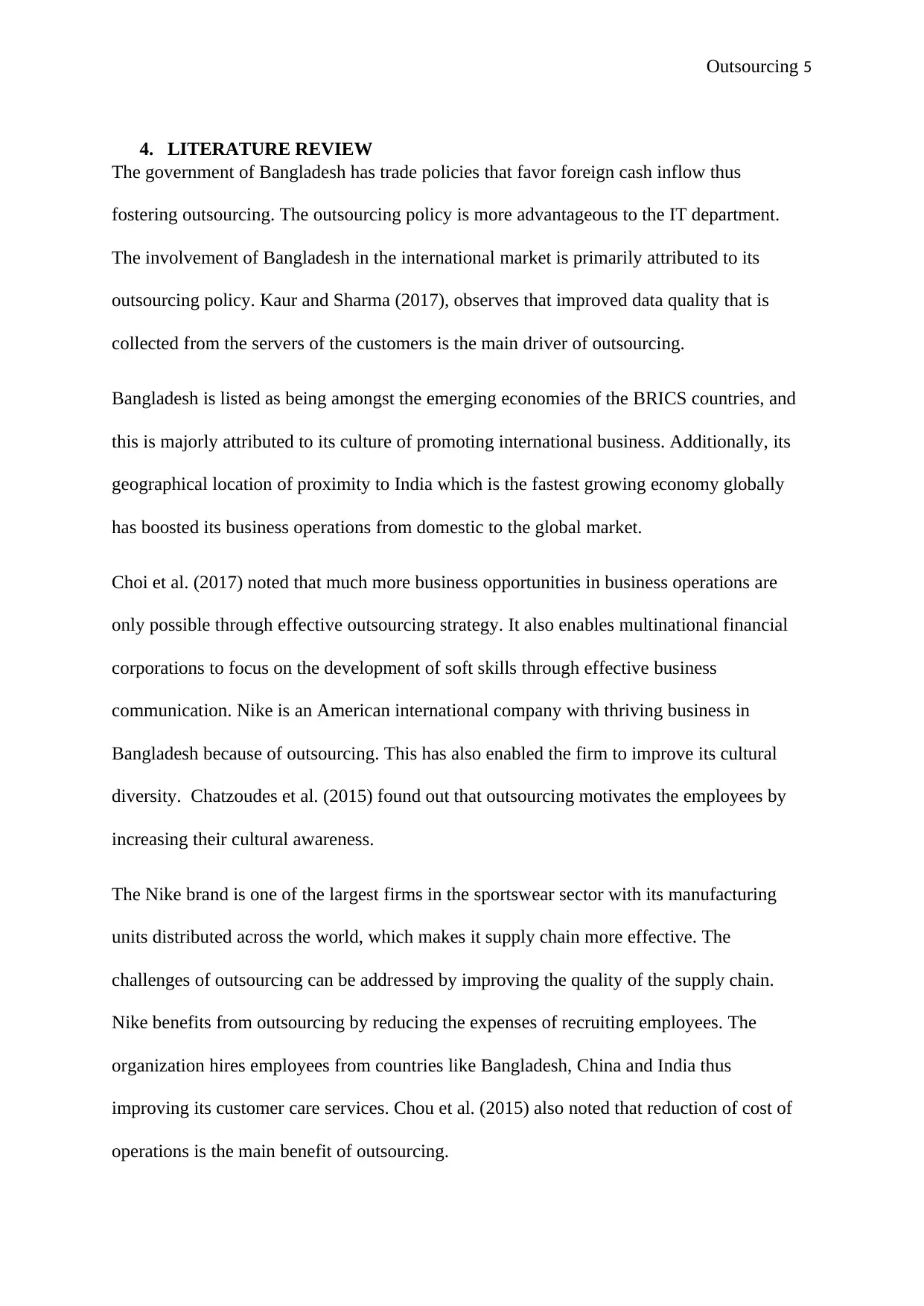
Outsourcing 5
4. LITERATURE REVIEW
The government of Bangladesh has trade policies that favor foreign cash inflow thus
fostering outsourcing. The outsourcing policy is more advantageous to the IT department.
The involvement of Bangladesh in the international market is primarily attributed to its
outsourcing policy. Kaur and Sharma (2017), observes that improved data quality that is
collected from the servers of the customers is the main driver of outsourcing.
Bangladesh is listed as being amongst the emerging economies of the BRICS countries, and
this is majorly attributed to its culture of promoting international business. Additionally, its
geographical location of proximity to India which is the fastest growing economy globally
has boosted its business operations from domestic to the global market.
Choi et al. (2017) noted that much more business opportunities in business operations are
only possible through effective outsourcing strategy. It also enables multinational financial
corporations to focus on the development of soft skills through effective business
communication. Nike is an American international company with thriving business in
Bangladesh because of outsourcing. This has also enabled the firm to improve its cultural
diversity. Chatzoudes et al. (2015) found out that outsourcing motivates the employees by
increasing their cultural awareness.
The Nike brand is one of the largest firms in the sportswear sector with its manufacturing
units distributed across the world, which makes it supply chain more effective. The
challenges of outsourcing can be addressed by improving the quality of the supply chain.
Nike benefits from outsourcing by reducing the expenses of recruiting employees. The
organization hires employees from countries like Bangladesh, China and India thus
improving its customer care services. Chou et al. (2015) also noted that reduction of cost of
operations is the main benefit of outsourcing.
4. LITERATURE REVIEW
The government of Bangladesh has trade policies that favor foreign cash inflow thus
fostering outsourcing. The outsourcing policy is more advantageous to the IT department.
The involvement of Bangladesh in the international market is primarily attributed to its
outsourcing policy. Kaur and Sharma (2017), observes that improved data quality that is
collected from the servers of the customers is the main driver of outsourcing.
Bangladesh is listed as being amongst the emerging economies of the BRICS countries, and
this is majorly attributed to its culture of promoting international business. Additionally, its
geographical location of proximity to India which is the fastest growing economy globally
has boosted its business operations from domestic to the global market.
Choi et al. (2017) noted that much more business opportunities in business operations are
only possible through effective outsourcing strategy. It also enables multinational financial
corporations to focus on the development of soft skills through effective business
communication. Nike is an American international company with thriving business in
Bangladesh because of outsourcing. This has also enabled the firm to improve its cultural
diversity. Chatzoudes et al. (2015) found out that outsourcing motivates the employees by
increasing their cultural awareness.
The Nike brand is one of the largest firms in the sportswear sector with its manufacturing
units distributed across the world, which makes it supply chain more effective. The
challenges of outsourcing can be addressed by improving the quality of the supply chain.
Nike benefits from outsourcing by reducing the expenses of recruiting employees. The
organization hires employees from countries like Bangladesh, China and India thus
improving its customer care services. Chou et al. (2015) also noted that reduction of cost of
operations is the main benefit of outsourcing.
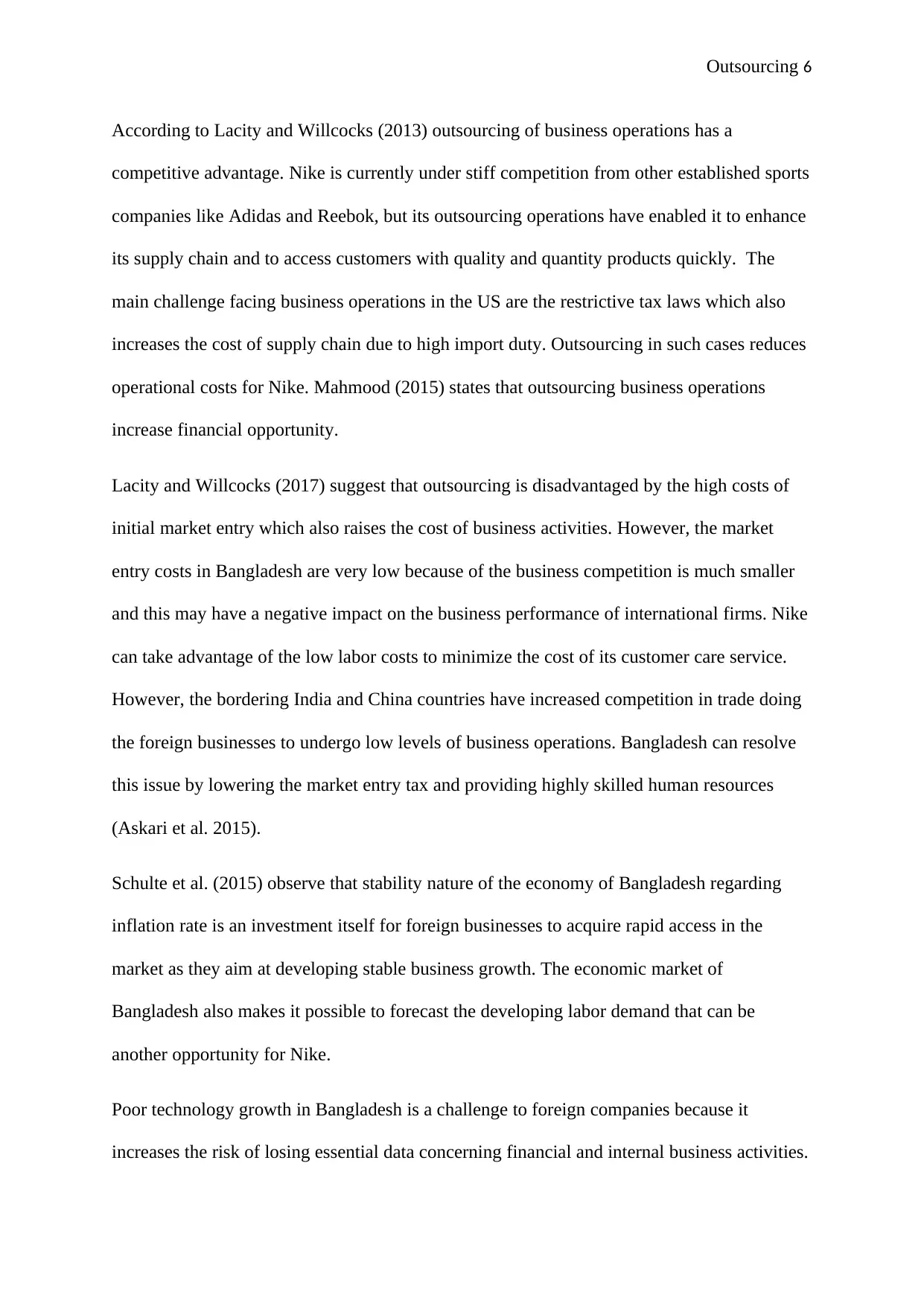
Outsourcing 6
According to Lacity and Willcocks (2013) outsourcing of business operations has a
competitive advantage. Nike is currently under stiff competition from other established sports
companies like Adidas and Reebok, but its outsourcing operations have enabled it to enhance
its supply chain and to access customers with quality and quantity products quickly. The
main challenge facing business operations in the US are the restrictive tax laws which also
increases the cost of supply chain due to high import duty. Outsourcing in such cases reduces
operational costs for Nike. Mahmood (2015) states that outsourcing business operations
increase financial opportunity.
Lacity and Willcocks (2017) suggest that outsourcing is disadvantaged by the high costs of
initial market entry which also raises the cost of business activities. However, the market
entry costs in Bangladesh are very low because of the business competition is much smaller
and this may have a negative impact on the business performance of international firms. Nike
can take advantage of the low labor costs to minimize the cost of its customer care service.
However, the bordering India and China countries have increased competition in trade doing
the foreign businesses to undergo low levels of business operations. Bangladesh can resolve
this issue by lowering the market entry tax and providing highly skilled human resources
(Askari et al. 2015).
Schulte et al. (2015) observe that stability nature of the economy of Bangladesh regarding
inflation rate is an investment itself for foreign businesses to acquire rapid access in the
market as they aim at developing stable business growth. The economic market of
Bangladesh also makes it possible to forecast the developing labor demand that can be
another opportunity for Nike.
Poor technology growth in Bangladesh is a challenge to foreign companies because it
increases the risk of losing essential data concerning financial and internal business activities.
According to Lacity and Willcocks (2013) outsourcing of business operations has a
competitive advantage. Nike is currently under stiff competition from other established sports
companies like Adidas and Reebok, but its outsourcing operations have enabled it to enhance
its supply chain and to access customers with quality and quantity products quickly. The
main challenge facing business operations in the US are the restrictive tax laws which also
increases the cost of supply chain due to high import duty. Outsourcing in such cases reduces
operational costs for Nike. Mahmood (2015) states that outsourcing business operations
increase financial opportunity.
Lacity and Willcocks (2017) suggest that outsourcing is disadvantaged by the high costs of
initial market entry which also raises the cost of business activities. However, the market
entry costs in Bangladesh are very low because of the business competition is much smaller
and this may have a negative impact on the business performance of international firms. Nike
can take advantage of the low labor costs to minimize the cost of its customer care service.
However, the bordering India and China countries have increased competition in trade doing
the foreign businesses to undergo low levels of business operations. Bangladesh can resolve
this issue by lowering the market entry tax and providing highly skilled human resources
(Askari et al. 2015).
Schulte et al. (2015) observe that stability nature of the economy of Bangladesh regarding
inflation rate is an investment itself for foreign businesses to acquire rapid access in the
market as they aim at developing stable business growth. The economic market of
Bangladesh also makes it possible to forecast the developing labor demand that can be
another opportunity for Nike.
Poor technology growth in Bangladesh is a challenge to foreign companies because it
increases the risk of losing essential data concerning financial and internal business activities.
⊘ This is a preview!⊘
Do you want full access?
Subscribe today to unlock all pages.

Trusted by 1+ million students worldwide
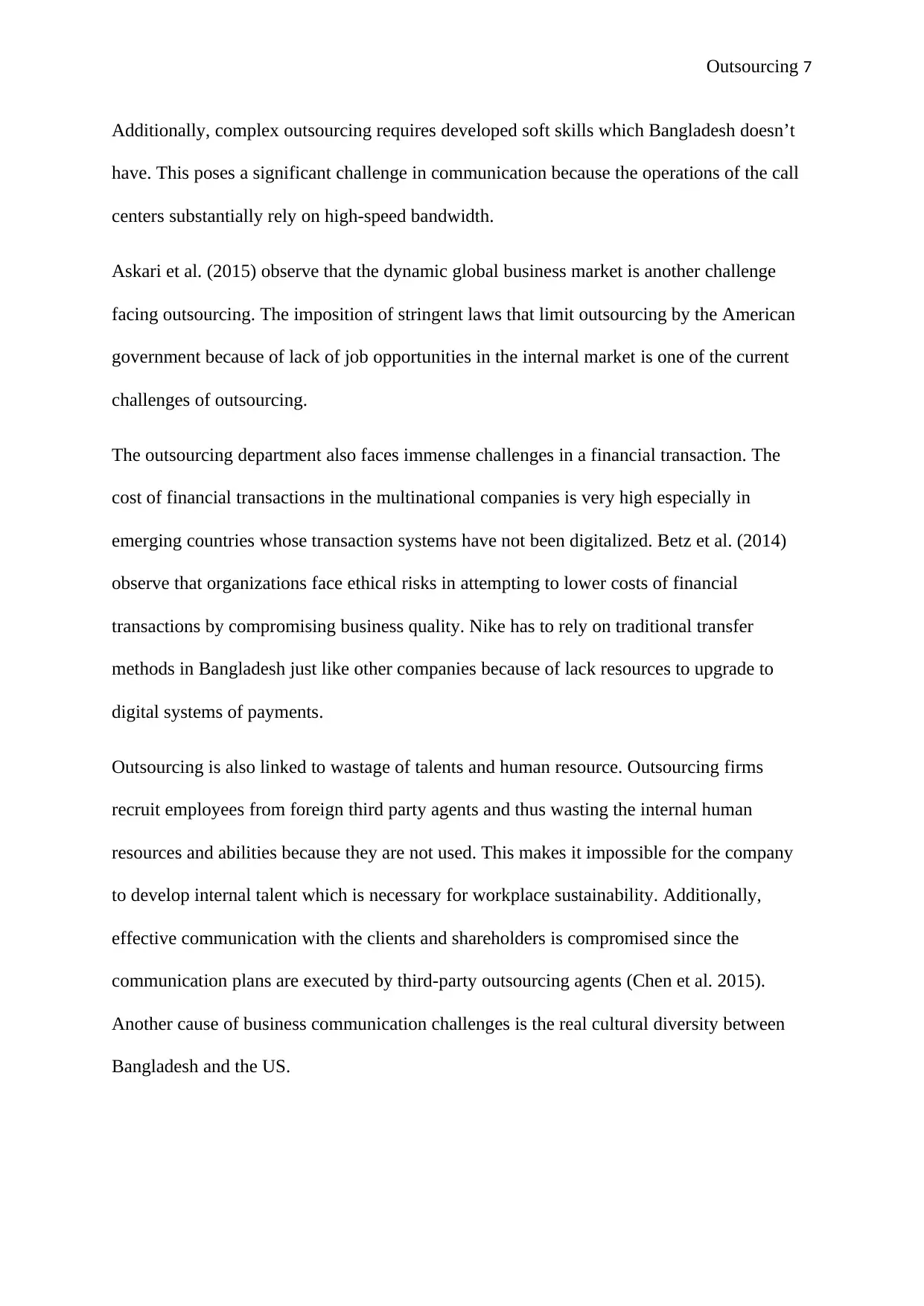
Outsourcing 7
Additionally, complex outsourcing requires developed soft skills which Bangladesh doesn’t
have. This poses a significant challenge in communication because the operations of the call
centers substantially rely on high-speed bandwidth.
Askari et al. (2015) observe that the dynamic global business market is another challenge
facing outsourcing. The imposition of stringent laws that limit outsourcing by the American
government because of lack of job opportunities in the internal market is one of the current
challenges of outsourcing.
The outsourcing department also faces immense challenges in a financial transaction. The
cost of financial transactions in the multinational companies is very high especially in
emerging countries whose transaction systems have not been digitalized. Betz et al. (2014)
observe that organizations face ethical risks in attempting to lower costs of financial
transactions by compromising business quality. Nike has to rely on traditional transfer
methods in Bangladesh just like other companies because of lack resources to upgrade to
digital systems of payments.
Outsourcing is also linked to wastage of talents and human resource. Outsourcing firms
recruit employees from foreign third party agents and thus wasting the internal human
resources and abilities because they are not used. This makes it impossible for the company
to develop internal talent which is necessary for workplace sustainability. Additionally,
effective communication with the clients and shareholders is compromised since the
communication plans are executed by third-party outsourcing agents (Chen et al. 2015).
Another cause of business communication challenges is the real cultural diversity between
Bangladesh and the US.
Additionally, complex outsourcing requires developed soft skills which Bangladesh doesn’t
have. This poses a significant challenge in communication because the operations of the call
centers substantially rely on high-speed bandwidth.
Askari et al. (2015) observe that the dynamic global business market is another challenge
facing outsourcing. The imposition of stringent laws that limit outsourcing by the American
government because of lack of job opportunities in the internal market is one of the current
challenges of outsourcing.
The outsourcing department also faces immense challenges in a financial transaction. The
cost of financial transactions in the multinational companies is very high especially in
emerging countries whose transaction systems have not been digitalized. Betz et al. (2014)
observe that organizations face ethical risks in attempting to lower costs of financial
transactions by compromising business quality. Nike has to rely on traditional transfer
methods in Bangladesh just like other companies because of lack resources to upgrade to
digital systems of payments.
Outsourcing is also linked to wastage of talents and human resource. Outsourcing firms
recruit employees from foreign third party agents and thus wasting the internal human
resources and abilities because they are not used. This makes it impossible for the company
to develop internal talent which is necessary for workplace sustainability. Additionally,
effective communication with the clients and shareholders is compromised since the
communication plans are executed by third-party outsourcing agents (Chen et al. 2015).
Another cause of business communication challenges is the real cultural diversity between
Bangladesh and the US.
Paraphrase This Document
Need a fresh take? Get an instant paraphrase of this document with our AI Paraphraser
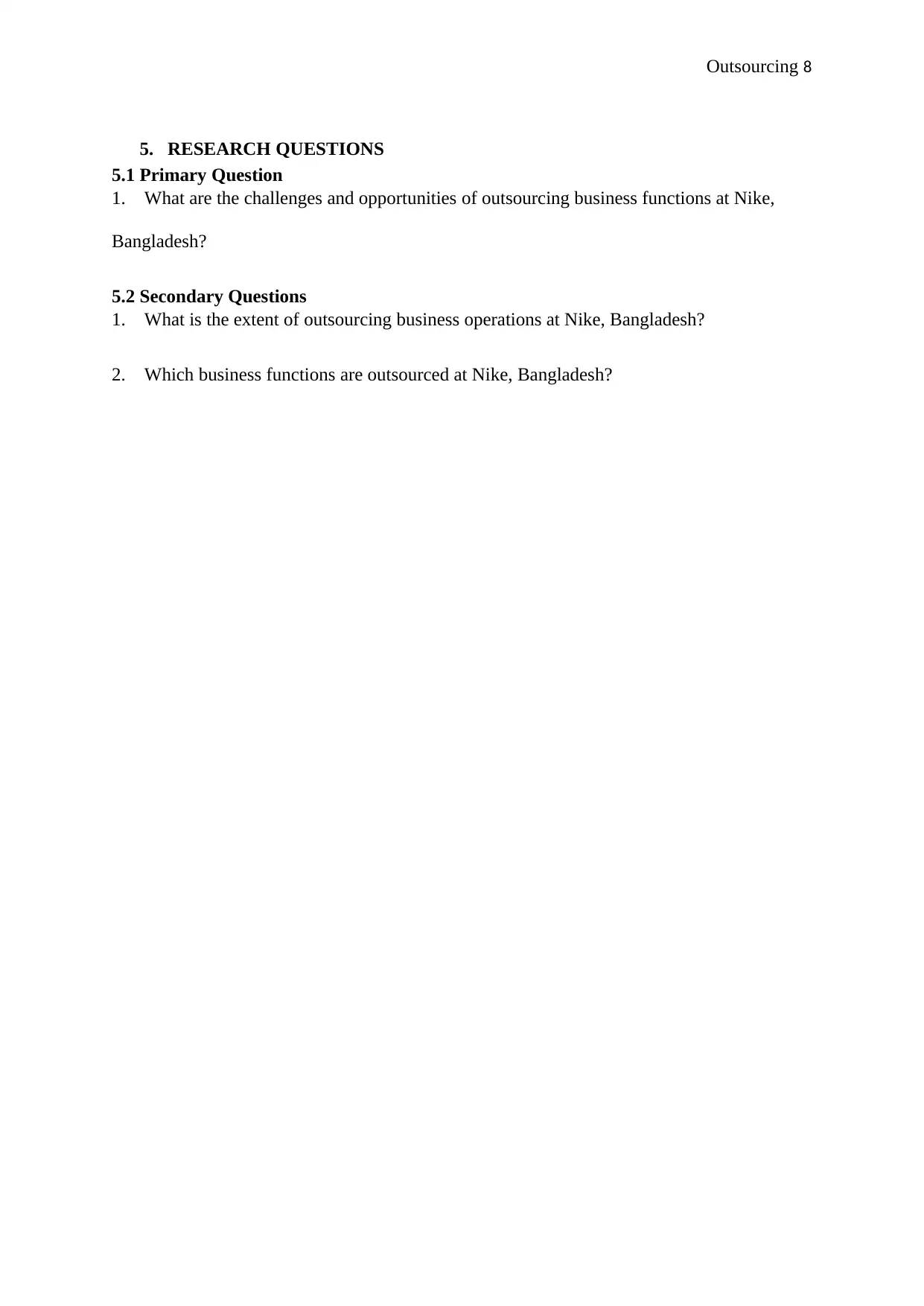
Outsourcing 8
5. RESEARCH QUESTIONS
5.1 Primary Question
1. What are the challenges and opportunities of outsourcing business functions at Nike,
Bangladesh?
5.2 Secondary Questions
1. What is the extent of outsourcing business operations at Nike, Bangladesh?
2. Which business functions are outsourced at Nike, Bangladesh?
5. RESEARCH QUESTIONS
5.1 Primary Question
1. What are the challenges and opportunities of outsourcing business functions at Nike,
Bangladesh?
5.2 Secondary Questions
1. What is the extent of outsourcing business operations at Nike, Bangladesh?
2. Which business functions are outsourced at Nike, Bangladesh?
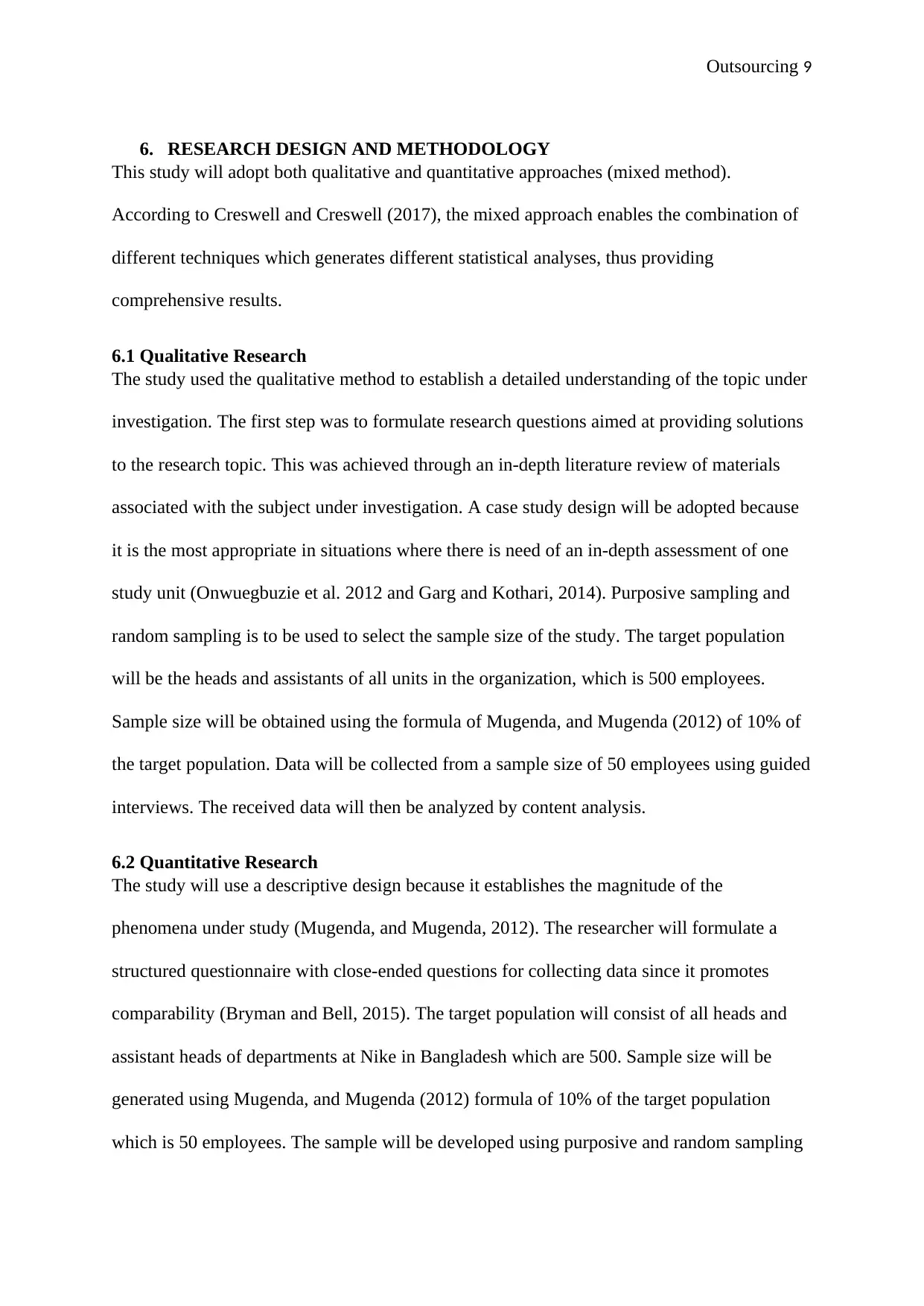
Outsourcing 9
6. RESEARCH DESIGN AND METHODOLOGY
This study will adopt both qualitative and quantitative approaches (mixed method).
According to Creswell and Creswell (2017), the mixed approach enables the combination of
different techniques which generates different statistical analyses, thus providing
comprehensive results.
6.1 Qualitative Research
The study used the qualitative method to establish a detailed understanding of the topic under
investigation. The first step was to formulate research questions aimed at providing solutions
to the research topic. This was achieved through an in-depth literature review of materials
associated with the subject under investigation. A case study design will be adopted because
it is the most appropriate in situations where there is need of an in-depth assessment of one
study unit (Onwuegbuzie et al. 2012 and Garg and Kothari, 2014). Purposive sampling and
random sampling is to be used to select the sample size of the study. The target population
will be the heads and assistants of all units in the organization, which is 500 employees.
Sample size will be obtained using the formula of Mugenda, and Mugenda (2012) of 10% of
the target population. Data will be collected from a sample size of 50 employees using guided
interviews. The received data will then be analyzed by content analysis.
6.2 Quantitative Research
The study will use a descriptive design because it establishes the magnitude of the
phenomena under study (Mugenda, and Mugenda, 2012). The researcher will formulate a
structured questionnaire with close-ended questions for collecting data since it promotes
comparability (Bryman and Bell, 2015). The target population will consist of all heads and
assistant heads of departments at Nike in Bangladesh which are 500. Sample size will be
generated using Mugenda, and Mugenda (2012) formula of 10% of the target population
which is 50 employees. The sample will be developed using purposive and random sampling
6. RESEARCH DESIGN AND METHODOLOGY
This study will adopt both qualitative and quantitative approaches (mixed method).
According to Creswell and Creswell (2017), the mixed approach enables the combination of
different techniques which generates different statistical analyses, thus providing
comprehensive results.
6.1 Qualitative Research
The study used the qualitative method to establish a detailed understanding of the topic under
investigation. The first step was to formulate research questions aimed at providing solutions
to the research topic. This was achieved through an in-depth literature review of materials
associated with the subject under investigation. A case study design will be adopted because
it is the most appropriate in situations where there is need of an in-depth assessment of one
study unit (Onwuegbuzie et al. 2012 and Garg and Kothari, 2014). Purposive sampling and
random sampling is to be used to select the sample size of the study. The target population
will be the heads and assistants of all units in the organization, which is 500 employees.
Sample size will be obtained using the formula of Mugenda, and Mugenda (2012) of 10% of
the target population. Data will be collected from a sample size of 50 employees using guided
interviews. The received data will then be analyzed by content analysis.
6.2 Quantitative Research
The study will use a descriptive design because it establishes the magnitude of the
phenomena under study (Mugenda, and Mugenda, 2012). The researcher will formulate a
structured questionnaire with close-ended questions for collecting data since it promotes
comparability (Bryman and Bell, 2015). The target population will consist of all heads and
assistant heads of departments at Nike in Bangladesh which are 500. Sample size will be
generated using Mugenda, and Mugenda (2012) formula of 10% of the target population
which is 50 employees. The sample will be developed using purposive and random sampling
⊘ This is a preview!⊘
Do you want full access?
Subscribe today to unlock all pages.

Trusted by 1+ million students worldwide
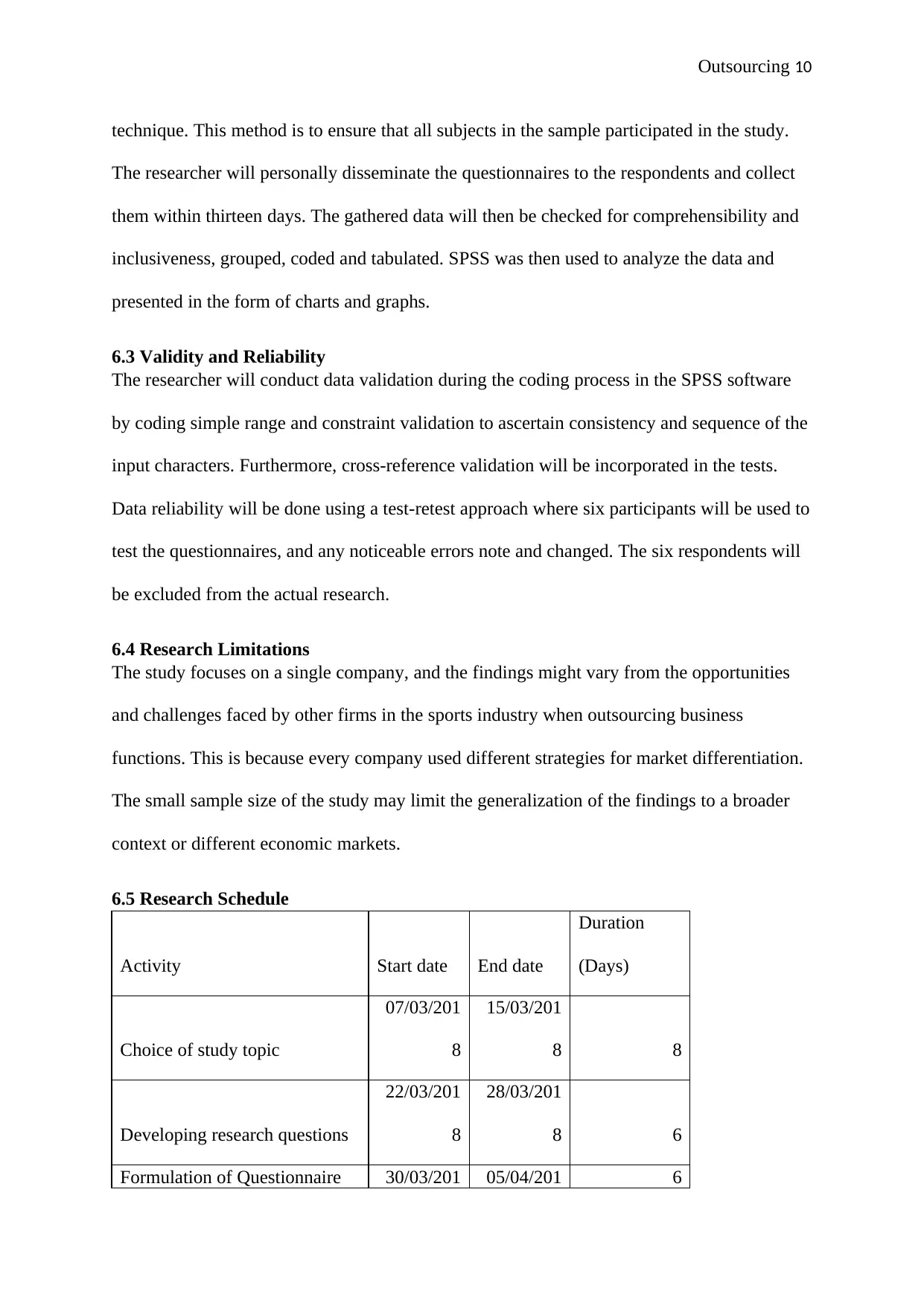
Outsourcing 10
technique. This method is to ensure that all subjects in the sample participated in the study.
The researcher will personally disseminate the questionnaires to the respondents and collect
them within thirteen days. The gathered data will then be checked for comprehensibility and
inclusiveness, grouped, coded and tabulated. SPSS was then used to analyze the data and
presented in the form of charts and graphs.
6.3 Validity and Reliability
The researcher will conduct data validation during the coding process in the SPSS software
by coding simple range and constraint validation to ascertain consistency and sequence of the
input characters. Furthermore, cross-reference validation will be incorporated in the tests.
Data reliability will be done using a test-retest approach where six participants will be used to
test the questionnaires, and any noticeable errors note and changed. The six respondents will
be excluded from the actual research.
6.4 Research Limitations
The study focuses on a single company, and the findings might vary from the opportunities
and challenges faced by other firms in the sports industry when outsourcing business
functions. This is because every company used different strategies for market differentiation.
The small sample size of the study may limit the generalization of the findings to a broader
context or different economic markets.
6.5 Research Schedule
Activity Start date End date
Duration
(Days)
Choice of study topic
07/03/201
8
15/03/201
8 8
Developing research questions
22/03/201
8
28/03/201
8 6
Formulation of Questionnaire 30/03/201 05/04/201 6
technique. This method is to ensure that all subjects in the sample participated in the study.
The researcher will personally disseminate the questionnaires to the respondents and collect
them within thirteen days. The gathered data will then be checked for comprehensibility and
inclusiveness, grouped, coded and tabulated. SPSS was then used to analyze the data and
presented in the form of charts and graphs.
6.3 Validity and Reliability
The researcher will conduct data validation during the coding process in the SPSS software
by coding simple range and constraint validation to ascertain consistency and sequence of the
input characters. Furthermore, cross-reference validation will be incorporated in the tests.
Data reliability will be done using a test-retest approach where six participants will be used to
test the questionnaires, and any noticeable errors note and changed. The six respondents will
be excluded from the actual research.
6.4 Research Limitations
The study focuses on a single company, and the findings might vary from the opportunities
and challenges faced by other firms in the sports industry when outsourcing business
functions. This is because every company used different strategies for market differentiation.
The small sample size of the study may limit the generalization of the findings to a broader
context or different economic markets.
6.5 Research Schedule
Activity Start date End date
Duration
(Days)
Choice of study topic
07/03/201
8
15/03/201
8 8
Developing research questions
22/03/201
8
28/03/201
8 6
Formulation of Questionnaire 30/03/201 05/04/201 6
Paraphrase This Document
Need a fresh take? Get an instant paraphrase of this document with our AI Paraphraser
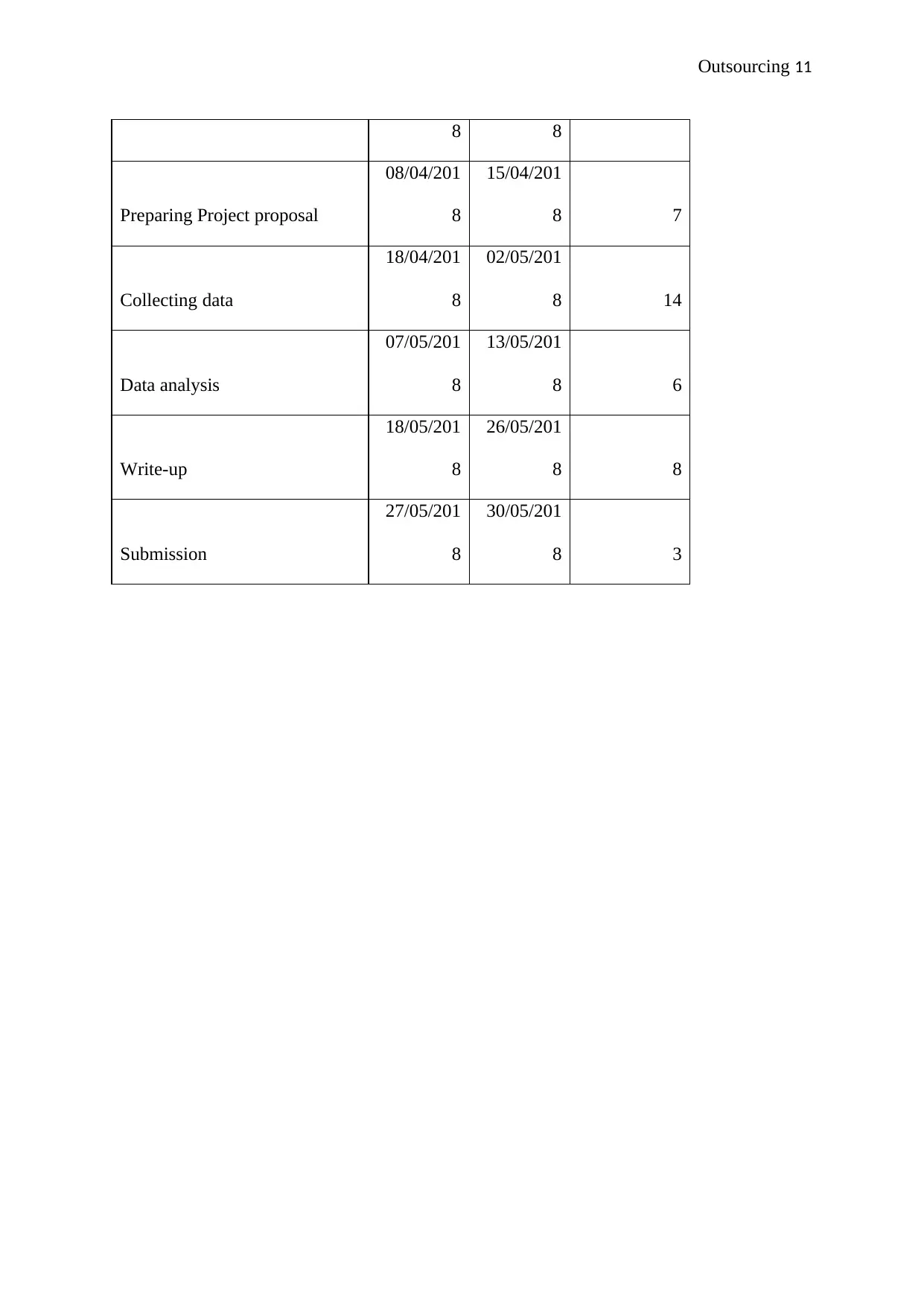
Outsourcing 11
8 8
Preparing Project proposal
08/04/201
8
15/04/201
8 7
Collecting data
18/04/201
8
02/05/201
8 14
Data analysis
07/05/201
8
13/05/201
8 6
Write-up
18/05/201
8
26/05/201
8 8
Submission
27/05/201
8
30/05/201
8 3
8 8
Preparing Project proposal
08/04/201
8
15/04/201
8 7
Collecting data
18/04/201
8
02/05/201
8 14
Data analysis
07/05/201
8
13/05/201
8 6
Write-up
18/05/201
8
26/05/201
8 8
Submission
27/05/201
8
30/05/201
8 3
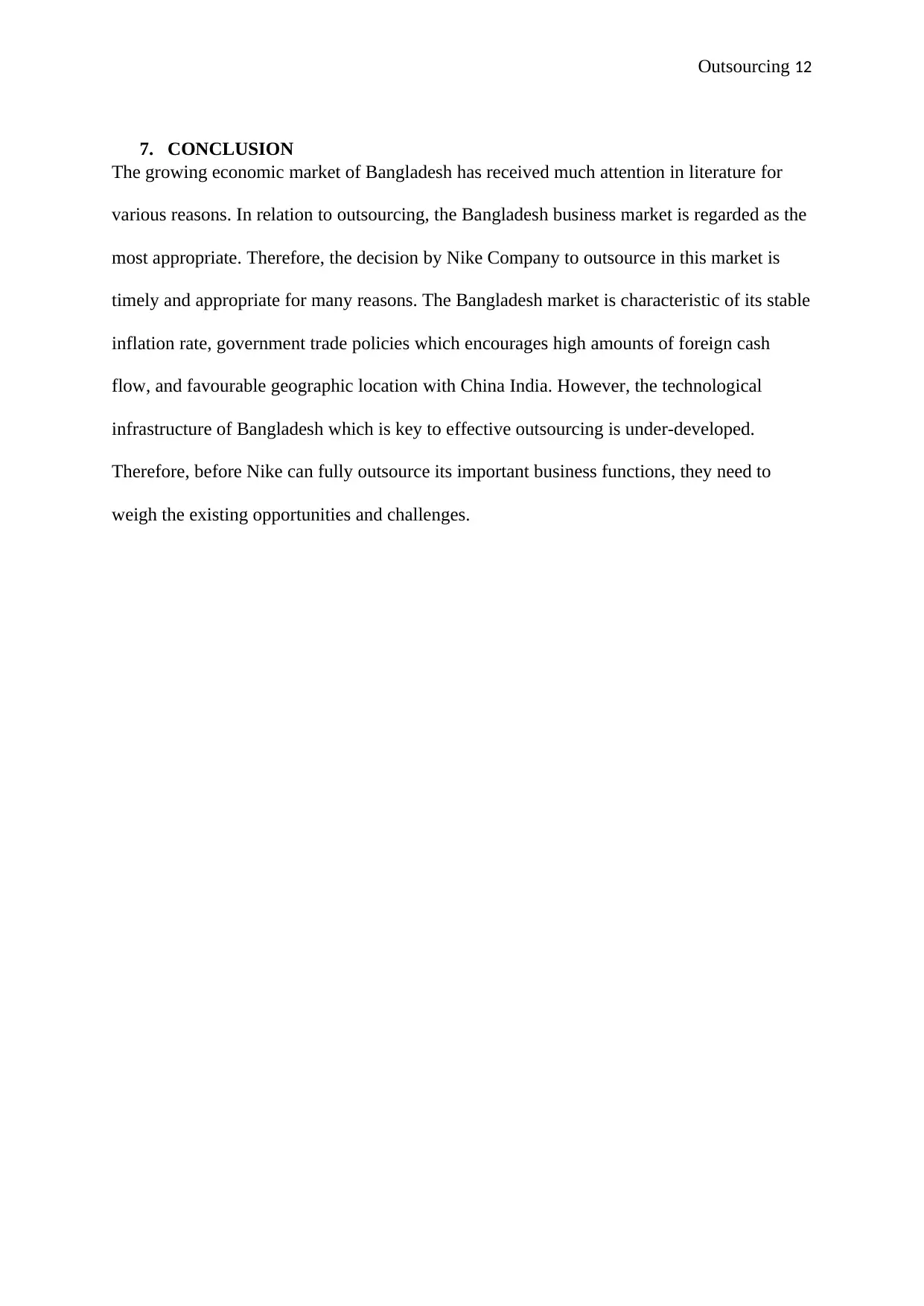
Outsourcing 12
7. CONCLUSION
The growing economic market of Bangladesh has received much attention in literature for
various reasons. In relation to outsourcing, the Bangladesh business market is regarded as the
most appropriate. Therefore, the decision by Nike Company to outsource in this market is
timely and appropriate for many reasons. The Bangladesh market is characteristic of its stable
inflation rate, government trade policies which encourages high amounts of foreign cash
flow, and favourable geographic location with China India. However, the technological
infrastructure of Bangladesh which is key to effective outsourcing is under-developed.
Therefore, before Nike can fully outsource its important business functions, they need to
weigh the existing opportunities and challenges.
7. CONCLUSION
The growing economic market of Bangladesh has received much attention in literature for
various reasons. In relation to outsourcing, the Bangladesh business market is regarded as the
most appropriate. Therefore, the decision by Nike Company to outsource in this market is
timely and appropriate for many reasons. The Bangladesh market is characteristic of its stable
inflation rate, government trade policies which encourages high amounts of foreign cash
flow, and favourable geographic location with China India. However, the technological
infrastructure of Bangladesh which is key to effective outsourcing is under-developed.
Therefore, before Nike can fully outsource its important business functions, they need to
weigh the existing opportunities and challenges.
⊘ This is a preview!⊘
Do you want full access?
Subscribe today to unlock all pages.

Trusted by 1+ million students worldwide
1 out of 18
Related Documents
Your All-in-One AI-Powered Toolkit for Academic Success.
+13062052269
info@desklib.com
Available 24*7 on WhatsApp / Email
![[object Object]](/_next/static/media/star-bottom.7253800d.svg)
Unlock your academic potential
Copyright © 2020–2025 A2Z Services. All Rights Reserved. Developed and managed by ZUCOL.




